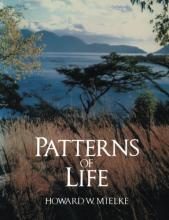Howard Mielke
Research Professor

Biography
Dr. Mielke has been studying lead and its effects on health for over 40 years. He is the creator of the Lead Lab project, a not for profit initiative dedicated to helping communities with lead contamination in children's play areas. He is currently a faculty member in Tulane School of Medicine's Pharmacology Department and part of the Environmental Signaling Laboratory research effort.
Dr. Mielke's research focuses on environmental signaling and human health. Recognizing the increasing importance of cities as the habitation for humanity, he has been researching and evaluating the status of the urban environment and its chemical impact on human health and disease.
Education
University of Michigan
University of Michigan
Macalester College
Articles
The urban rise and fall of air lead (Pb) and the latent surge and retreat of societal violence
2012
We evaluate air Pb emissions and latent aggravated assault behavior at the scale of the city. We accomplish this by regressing annual Federal Bureau of Investigation aggravated assault rate records against the rise and fall of annual vehicle Pb emissions in Chicago (Illinois), Indianapolis (Indiana), Minneapolis (Minnesota), San Diego (California), Atlanta (Georgia), and New Orleans (Louisiana). Other things held equal, a 1% increase in tonnages of air Pb released 22 years prior raises the present period aggravated assault rate by 0.46% (95% CI, 0.28 to 0.64)...
Re-suspension of lead contaminated urban soil as a dominant source of atmospheric lead in Birmingham, Chicago, Detroit and Pittsburgh, USA
2012
Soils in older areas of cities are highly contaminated by lead, due largely to past use of lead additives in gasoline, the use of lead in exterior paints, and industrial lead sources. Soils are not passive repositories and periodic re-suspension of fine lead contaminated soil dust particulates (or aerosols) may create seasonal variations of lead exposure for urban dwellers. Atmospheric soil and lead aerosol data from the Interagency Monitoring of Protected Visual Environments (IMPROVE) database were obtained for Pittsburgh (Pennsylvania), Detroit (Michigan), Chicago (Illinois), and Birmingham (Alabama), USA...
Estimation of leaded (Pb) gasoline's continuing material and health impacts on 90 US urbanized areas
2011
The subject of this paper is lead (Pb) additives in gasoline and their material and health impact from Pb dust inputs into 90 US urbanized areas (UAs). The mass of Pb additives for 90 UAs as a total of the US Pb additives in 1982 were estimated from vehicle travel, vehicle fuel economy (miles/gallon), ratio of leaded to unleaded fuel, and Pb/gallon. About 500 billion (109) miles of travel in 90 UA's during 1982 account for ~ 18,000 metric tons (MT), or nearly 30% of the US Pb additives in 1982...
Media Appearances
FDA Bans Lead-Based Neurotoxin from Consumer Hair Dyes
The petition was filed in February 2017 by EWG, Environmental Defense Fund, Earthjustice, Center for Environmental Health, Healthy Homes Collaborative, Health Justice Project of Loyola University Chicago School of Law, Breast Cancer Fund, Natural Resources Defense Council, Improving Kids’ Environment, Consumers Union and Howard Mielke, a lead expert who is a research professor at the Tulane School of Medicine. The petitioners cited major advances in science since the 1980 FDA decision allowing lead to remain in hair dye...
You should wipe your hands after catching Mardi Gras beads. But not because of germs.
In the 1970s, an environmental scientist named Dr. Howard Mielke was directly involved in the legal efforts to phase out lead in gasoline. Today, at Tulane University’s Department of Pharmacology, he researches the links between lead, the environment and skin absorption in New Orleans...
Mardi Gras 2018: 90,000 Pounds of Beads Found in New Orleans Storm Drains
“If children pick up the beads, they will become exposed to a fine dusting of lead,” Howard Mielke, a pharmacology professor at Tulane University, told The Conversation. “Beads obviously attract people, and they’re designed to be touched, coveted.”...
Tulane Today Mentions
In the News
Eos: Leaded Soil Endangers Residents in New York Neighborhoods
Grist: Wildfires are getting worse, and so is the deadly smoke they bring with them
WWL-TV: Katrina may have lowered lead levels in soil
Morningstar: UPDATE: The toxic tale of those coveted Mardi Gras beads
The Oregonian: Lead exposure typically comes from air, not often from water
Earth Justice: Dangerous Dyes: Let’s Get Lead Out of Our Hair
The Oregonian: Portland schools struggle with more potent toxic scare: lead paint
Think Progress: The lead crisis: Tackling an invisible, dangerous neurotoxin
NOLA.com: Less lead in New Orleans soils, children's blood, 10 years after Katrina: study
Medical Xpress: Researcher advocates removal of lead from hair dye





